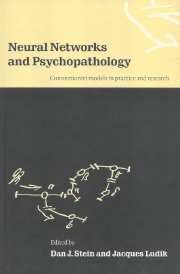Book contents
- Frontmatter
- Contents
- List of contributors
- Preface
- Part one General Concepts
- 1 Neural networks and psychopathology: an introduction
- 2 The history of neural network research in psychopathology
- 3 Neural network models in psychiatric diagnosis and symptom recognition
- 4 Neural networks and psychopharmacology
- 5 A connectionist view of psychotherapy
- 6 Modulatory mechanisms in mental disorders
- Part two Clinical disorders
- Epilogue
- Index
2 - The history of neural network research in psychopathology
from Part one - General Concepts
Published online by Cambridge University Press: 12 January 2010
- Frontmatter
- Contents
- List of contributors
- Preface
- Part one General Concepts
- 1 Neural networks and psychopathology: an introduction
- 2 The history of neural network research in psychopathology
- 3 Neural network models in psychiatric diagnosis and symptom recognition
- 4 Neural networks and psychopharmacology
- 5 A connectionist view of psychotherapy
- 6 Modulatory mechanisms in mental disorders
- Part two Clinical disorders
- Epilogue
- Index
Summary
Introduction
The use of neural networks for the study of psychopathological phenomena is not new, but rather has a rich historical tradition. One striking feature of this tradition is that from the very inception of the idea of the neuron, psychiatrists have used the notion of networks and their pathology to account for psychopathological phenomena. Moreover, many advances in neural network research were either made by psychiatrists or were put forward in relation to psychopathology. In other words, neural network studies of psychopathological phenomena are by no means a ‘late add on’ to the mainstream of neural network research, but have always been at the heart of the matter. Neural networks were drawn by Freud and Exner to explain disorders of cognition, affect and consciousness. Carl Wernicke (1906) coined the term ‘Sejunktion’ to denote the functional decoupling of cortical areas, which he suggested was the cause of psychotic symptoms such as hallucinations and delusions. Emil Kraepelin (1892) and his group of experimentally oriented psychiatrists reasoned about associative networks and psychosis. Not least, Eugen Bleuler (1911/1950) – inspired by the experimental work carried out by his resident Carl-Gustav Jung (1906/1979) – saw the disruption of these networks as the hallmark of schizophrenia.
Various developments in many fields have contributed to the present surge of neural network research. The historical material discussed in this chapter is organized by time and by topic.
Present-day connectionism takes it for granted that there are neurons, summing up action potentials coming via the connections among them, the synapses. These fundamental ideas, however, have their history, and are the starting point of this chapter.
- Type
- Chapter
- Information
- Neural Networks and PsychopathologyConnectionist Models in Practice and Research, pp. 14 - 33Publisher: Cambridge University PressPrint publication year: 1998



